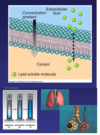Biochemistry Flashcards
Explain Homeostasis
Homeostasis
- Homeostasis is that property of a system, especially a living organism, which regulates its internal environment so as to maintain a stable, constant condition.
- Multiple dynamic equilibrium adjustments, controlled by interrelated regulation mechanisms, make homeostasis possible.
- Means “unchanging” but dynamic - Balance, Equilibrium, Stability
- Swedish: Jämvikt
Give examples of trade offs that are included in Homeostasis
Homeostasis
- Body temperature
- Nutrients
- Oxygen levels
- Water content
- Salinity
- pH Acid/Base
- Energy
- Blood glucose
- Blood Pressure
- Calcium
- …
Explain the meaning of Feedback systems
Feedback systems
- To keep homeostasis
- On all levels from cells to organ systems
- Nerves and endocrine systems
Describe basic chain of reactions for Feedback Systems
Basic chain of reactions for Feedback Systems
- Stimulus
- Monitoring/Receptors
- Control Center
- Action/Effectors
- Response
What is Biochemistry?
Biochemistry
- Biochemistry is the study of the chemical processes and transformations in living organisms.
- It deals with the structure and function of cellular components, such as proteins, carbohydrates, lipids, nucleic acids, and other biomolecules.
Which are the main chemical elements in the human body?
Chemical elements in the human body
- Oxygen - O - 65%
- Carbon - C - 18.5%
- Hydrogen - H - 9.5 %
- Nitrogen - N - 3.2 %
- Other - 3.8%
(Top five => 96%)
Which are the chemical elements included in the 3.8 % referred to as others?
Others…
- Calcium - Ca - 1.5 %
- Phosphor - P - 1 %
- Potassium - K - 0.35 %
- Sulfur - S - 0.25 %
- Sodium - Na - 0.2 %
- Chlorine - Cl - 0.2 %
- Magnesium - Mg - 0.1 %
- Iron - Fe - 0.005%
- Trace elements - 0.2 %
Give example of trace elements and how large amount of the chemical elements they comprise.
Trace element is approximately 0.2% of the chemical elements
Examples:
- Aluminium
- Boron
- Chromium
- Cobalt
- Zinc
- Cobolt
- Copper
- Fluorine
- Tin
- Vanadium
- Iodine
- Manganese
- Molybdenum
- Selenium
Name a major classification of chemical compounds?
Inorganic and organic compunds
Give example of Inorganic compounds
Inorganic compounds
- Water
- Acid (ex. HCl)
- Bases (ex. KOH)
- Salt (ex. KCl)

Give examples of pH for Inorganic compounds
pH-levels for Inorganic compounds

Explain why and how Iodine deficiency appears
Iodine (I) deficiency

What is the pH of blood?
Blood has a pH of 7.35-7.45
Give examples of Organic Compounds
Organic Compunds
- Carbohydrates
- Lipids
- Nucleic Acids
- Proteins
- ATP
What is the main molecular form of Carbohydrates
Carbohydrates
Cn(H2O)n
What are the main classification of Carbohydrates?
Carbohydrates
- Monosaccharides
- Disaccharides
- Polysaccharides
Give examples of Monosaccharides
Carbohydrates - Monosaccharides
- Glucose (energy source)
- Fructose
- Galactose
- Ribose (RNA)
- Deoxyribose (DNA)

Give examples of Disaccharides
Carbohydrates Dissacharides
- Sucrose (glucose, fructose)
- Maltose (glucose, glucose)
- Lactose (glucose, galactoes)

Explain Hypolactasia
Lactose intolerance - Hypolactasia

Give examples of Polysaccharides
Carbohydrate - Polysaccharides (40-3000)
- Glycogen (glucose)
- Starches (glucose)























